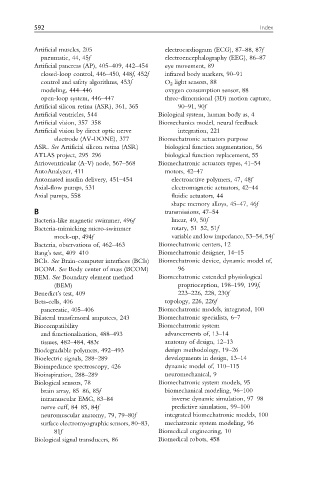Page 600 - Handbook of Biomechatronics
P. 600
592 Index
Artificial muscles, 205 electrocardiogram (ECG), 87–88, 87f
pneumatic, 44, 45f electroencephalography (EEG), 86–87
Artificial pancreas (AP), 405–409, 442–454 eye movement, 89
closed-loop control, 446–450, 448f, 452f infrared body markers, 90–91
control and safety algorithms, 453f O 2 light sensors, 88
modeling, 444–446 oxygen consumption sensor, 88
open-loop system, 446–447 three-dimensional (3D) motion capture,
Artificial silicon retina (ASR), 361, 365 90–91, 90f
Artificial ventricles, 544 Biological system, human body as, 4
Artificial vision, 357–358 Biomechanics model, neural feedback
Artificial vision by direct optic nerve integration, 221
electrode (AV-DONE), 377 Biomechatronic actuators purpose
ASR. See Artificial silicon retina (ASR) biological function augmentation, 56
ATLAS project, 295–296 biological function replacement, 55
Atrioventricular (A-V) node, 567–568 Biomechatronic actuators types, 41–54
AutoAnalyzer, 411 motors, 42–47
Automated insulin delivery, 451–454 electroactive polymers, 47, 48f
Axial-flow pumps, 531 electromagnetic actuators, 42–44
Axial pumps, 558 fluidic actuators, 44
shape memory alloys, 45–47, 46f
B transmissions, 47–54
Bacteria-like magnetic swimmer, 496f linear, 49, 50f
Bacteria-mimicking micro-swimmer rotary, 51–52, 51f
mock-up, 494f variable and low impedance, 53–54, 54f
Bacteria, observations of, 462–463 Biomechatronic centers, 12
Bang’s test, 409–410 Biomechatronic designer, 14–15
BCIs. See Brain-computer interfaces (BCIs) Biomechatronic device, dynamic model of,
BCOM. See Body center of mass (BCOM) 96
BEM. See Boundary element method Biomechatronic extended physiological
(BEM) proprioception, 198–199, 199f,
Benedict’s test, 409 223–226, 228, 230f
Beta-cells, 406 topology, 226, 226f
pancreatic, 405–406 Biomechatronic models, integrated, 100
Bilateral transfemoral amputees, 243 Biomechatronic specialists, 6–7
Biocompatibility Biomechatronic system
and functionalization, 488–493 advancements of, 13–14
tissues, 482–484, 483t anatomy of design, 12–13
Biodegradable polymers, 492–493 design methodology, 19–26
Bioelectric signals, 288–289 developments in design, 13–14
Bioimpedance spectroscopy, 426 dynamic model of, 110–115
Bioinspiration, 288–289 neuromechanical, 9
Biological sensors, 78 Biomechatronic system models, 95
brain array, 85–86, 85f biomechanical modeling, 96–100
intramuscular EMG, 83–84 inverse dynamic simulation, 97–98
nerve cuff, 84–85, 84f predictive simulation, 99–100
neuromuscular anatomy, 79, 79–80f integrated biomechatronic models, 100
surface electromyographic sensors, 80–83, mechatronic system modeling, 96
81f Biomedical engineering, 10
Biological signal transducers, 86 Biomedical robots, 458

